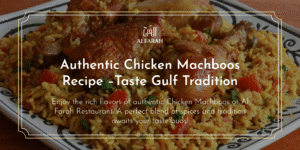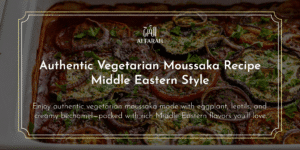Introduction to Mutabbal
If you enjoy Middle Eastern cuisine, you’ve likely encountered Mutabbal. But what exactly is this delicious dip, and why is it cherished worldwide?
What is Mutabbal?
Mutabbal is a delicious thick eggplant cream that is superficially similar to another similar dish known as Baba Ghanoush. Accompanying and gracing many Middle Eastern dinner tables, it is often featured on mezze platters. Mutabbal is mostly made of grilled eggplants, tahine, garlic, lemon juice and olive oil and it is a rich-tasted dish with immense appeal.
Origins and History
Further, the origin of Mutabbal is unclear, however, there are theories about it being a Levantine dish, so the Levant area which includes present-day Countries such as Lebanon, Syria, Jordan, and Palestine might be its birthplace. It has evolved over times appropriating the Middle East and other parts of the world as one of the most globally admired meals.
Ingredients Needed for Mutabbal
To make Mutabbal, no complicated process is required; it just involves the use of fresh good ingredients.
Main Ingredients
- Eggplants: The core ingredient in Mutabbal, they are roasted to creamy until they are done.
- Tahini: Gives a nutty touch to the dish and is rub tasted to add extra thickness to the dish.
- Garlic: Adds a slight hint of sharpness, which is associated with the terms pungency.
- Lemon Juice: Used to intensify the brightness and provide sharpness/acidity.
- Olive Oil: Key benefit since it enhances the texture and taste of the food by providing the necessary protein to it.
- Salt: To taste.
Optional Additions
- Yogurt: Some of the changes made are with garnishing in which yogurt is included for creaminess.
- Cumin: Provides the sensation of warmth and rusticity while maintaining a subtle, earthen taste.
- Paprika: Gently spicy.
Health Benefits of Mutabbal
Speaking of Mutabbal, not only is it yummy but it is also healthy too.
Nutritional Value
Low in Calories: The above dish is ideal for use in calorie-restriction diets.
Rich in Fiber: Indeed, all thanks to the eggplants.
Healthy Fats: Prepared out of olive oil and tahine.
Vitamins and Minerals: These are Vitamin B, C and E; potassium; and antioxidants.
Dietary Considerations
It is, of course, a gluten-free dish and can also be made vegan if the optional garnishing ingredients like toasted nuts and seeds are not added.
How to Make Mutabbal at Home
Ready to prepare Mutabbal yourself? Here’s a simple recipe to get started.
Step-by-Step Recipe
- Roast the Eggplants: Preheat your oven to 400°F (200°C). Prick the eggplants with a fork and place them on a baking sheet. Roast for 30-40 minutes until charred and tender.
- Prepare Ingredients: Once cooled, peel and scoop out the eggplant flesh into a bowl.
- Mix Ingredients: Add tahini, minced garlic, lemon juice, and salt to the bowl. Mix until smooth.
- Blend (Optional): For a smoother texture, use a food processor.
- Adjust Consistency: Add more tahini or olive oil for a creamier texture.
- Serve: Drizzle with olive oil and garnish with paprika or fresh herbs if desired.
Tips for the Perfect Mutabbal
- Char Eggplants Well: Achieves smoky flavor.
- Use Fresh Lemon Juice: Enhances taste.
- Adjust Flavors: Tailor to personal preference.
Serving Suggestions
Mutabbal is a very useful dish to go with other foods and can be combined with many types of meals.
Traditional Accompaniments
- Pita Bread: That one can be used for dipping, like a form of classic.
- Vegetable Sticks: A patch and rows of carrots, cucumbers, and bell peppers on the farm.
- As part of a Mezze Platter: Next to well-known dishes such as hummus, falafel, and others.
Modern Twists
- Spread: It is suggested that it may be used as a sandwich spread or spread on toast.
- Bowl Topping: Improves the strength of the grain bowls.
Mutabbal vs. Baba Ghanoush
While these two dips may seem the same, they are different in terms of their particularities.
Key Differences
Ingredients: Mutabbal is a dish without numerous ingredients as compared to the tahini magic bananas.
Texture: Mutabbal is more soothed than concentrating Baba Ghanoush.
Similarities
- Base Ingredient: Both utilize roasted eggplants as an incorporation to their respective dishes.
- Flavor: These two food items primarily have a savory taste, although subtle flavors of smoke are evident in both.
Regional Variations of Mutabbal
While the core recipe remains, regional tweaks add diversity.
Syrian Style
- Sweet-sour pomegranate molasses is an ingredient in many cases of this type of local sauce.
Lebanese Style
- Lemonier and garlic-forward.
Other Variations
- Spiced or herb-infused versions.
Pairing Mutabbal with Other Dishes
Mezze Platters
- Complementing it, you will find a usual side like hummus, olives, etc.
Main Courses
- Heighten the flavor of barbecued meats and fish.
Popular Mutabbal Recipes
- See a collection of recipes that use sour cream instead of mayonnaise.
Classic Recipe
- Eggplant with tahini sauce, garlic-and-lemon-marinated olive oil.
Spicy Mutabbal
- Adds chili for heat.
Herb-Infused Mutabbal
- Soft food like chicken or fish meat, fresh vegetables, and fruits like avocadoes, spinach, tomatoes, cucumber, and any type of salad.
Storing and Preserving Mutabbal
Practice proper storage and handling of Mutabbal to make it last longer and have great taste when consumed.
Best Practices
- On the other hand, you need to store it airtight in the refrigerator.
Shelf Life
- Can be stored for up to one week in a refrigerator, but the texture can vary after freezing.
Cultural Significance of Mutabbal
- Aside from being a dish that may be served during gatherings, Mutabbal is culturally significant.
Middle Eastern Cuisine
- A prime component of regional cookery.
Occasions
- Celebrated during festivals like Ramadan.
Common Mistakes to Avoid When Making Mutabbal
Tips for perfecting your Mutabbal.
Pitfalls
- Under-roasting eggplants reduce flavor.
- Adding tahini so that it isn’t dominant in the recipe but also adds richness.
Mutabbal in Restaurants
Explaining the realities of going to a restaurant.
Expectations
- The seafood flavor is in the bacon, very genuine, with a hint of char.
- Often served as one of the numerous small dishes served with a Turkish alcoholic beverage known as ‘mekkle’.
Choosing the Best
- Opt for fresh, well-balanced flavors.
Mutabbal: Perfect for Any Occasion
Mutabbal is an exquisite dip made from roasted eggplants that pair well with creamy tahini, lemon, and garlic. Although it is one of the many components of a Mezze platter, Mutabbal is a delicious entrée to Middle Eastern food. Even with fairly modest ingredients and other cooking styles or methods in which it could be served, it’s a great dish that everyone should know about. Visit Restaurant Networks to buy and sell used restaurant equipment.










